Content is from Kirkbride et al. 2006Kirkbride et al. 2006:
Kirkbride JH, Jr, Gunn CR, and Dallwitz MJ. 2006. Family guide for fruits and seeds, vers. 1.0. Accessed September 2020-January 2022. URL: https://nt.ars-grin.gov/seedsfruits/keys/frsdfam/index.cfm ., without modification.
Updates are forthcoming.
Fruits: Pistil(s) compound; 1; 1-pistillate; with carpels united. Fruit pericarpium, or anthocarpanthocarp:
simple or compound and including some tissue of non-ovarian origin (accessory tissue) ; simple, or compound; coccum (Spjut Fig. 23A-B & 3 families: Connaraceae, Myristicaceae, Proteaceae), or folliclefollicle:
; simple, or compound; coccum (Spjut Fig. 23A-B & 3 families: Connaraceae, Myristicaceae, Proteaceae), or folliclefollicle:
a dry to (rarely) fleshy fruit derived from a single carpel that opens along a single longitudinal suture, derived from a single, superior, simple ovary; the seeds may be arillate or with a fleshy testa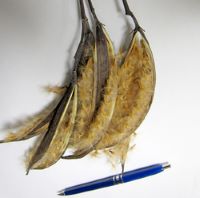 (Spjut 6 families: Apocynaceae, Asclepiadaceae, Cercidiphyllaceae, Connaraceae, Crossosomataceae, Proteaceae), or drupedrupe:
(Spjut 6 families: Apocynaceae, Asclepiadaceae, Cercidiphyllaceae, Connaraceae, Crossosomataceae, Proteaceae), or drupedrupe:
(indehiscent drupe) a fleshy, indehiscent fruit with one more hard pits enclosing seeds, derived from single, superior, simple or compound ovary; (dehiscent drupe) a fruit with a dry or fibrous to fleshy or leathery outer husk that early to tardily breaks apart (or opens), exposing one or more nutlike pits enclosing the seeds ; folliconum (Spjut Fig. 30D & only family); compound; achenoconum (Spjut Figs. 5A-E & 6A-B & 3 families: Betulaceae, Cannabaceae, Proteaceae), or sorosus; without persistent central column; 1-seeded to many-seeded; 1-seeded (to many); with 1-carpellate; not sulcatesulcate:
; folliconum (Spjut Fig. 30D & only family); compound; achenoconum (Spjut Figs. 5A-E & 6A-B & 3 families: Betulaceae, Cannabaceae, Proteaceae), or sorosus; without persistent central column; 1-seeded to many-seeded; 1-seeded (to many); with 1-carpellate; not sulcatesulcate:
surface relief—having one or more elongate, relatively narrow and shallow depressions or grooves ; in transection tereteterete:
; in transection tereteterete:
approximately circular in cross section; width and thickness approximately equal
 ; apexapex:
; apexapex:
the point farthest from the point of attachment, or the "tip" of an organ not beaked; dehiscentdehiscent:
not beaked; dehiscentdehiscent:
(v. dehisce) splitting open at maturity to release contents (of a fruit) , or indehiscentindehiscent:
, or indehiscentindehiscent:
not opening on its own, as in a fruit
 (Grevilleoid genera). Dehiscentdehiscent:
(Grevilleoid genera). Dehiscentdehiscent:
(v. dehisce) splitting open at maturity to release contents (of a fruit) unit seed(s). Dehiscentdehiscent:
unit seed(s). Dehiscentdehiscent:
(v. dehisce) splitting open at maturity to release contents (of a fruit) at apexapex:
at apexapex:
the point farthest from the point of attachment, or the "tip" of an organ ; and shedding seeds; without replumreplum:
; and shedding seeds; without replumreplum:
the rim, formed by the persistent placentas, and connected by a false septum in Brassicaceae fruits. The fruit valves are attached to this rim and separate from it in dehiscent fruits.
. Epicarpepicarp:
outer layer of fruit wall or pericarp, if divided into layers; note here used synonymously with exocarp durable; without armature; without wing(s); without apicalapical:
durable; without armature; without wing(s); without apicalapical:
at or pertaining to the end of the seed or fruit distal from its point of attachment (i.e., base)
respiratory hole. Mesocarpmesocarp:
the middle layer of the pericarp, if divided into layers present, or absent. Endocarpendocarp:
present, or absent. Endocarpendocarp:
the inner layer of the pericarp, if divided into layers present, or absent; not separating from exocarpexocarp:
present, or absent; not separating from exocarpexocarp:
outer layer of fruit wall or pericarp, if divided into layers; note here used synonymously with epicarp ; hard, or thin; not splitting into 1-seeded pyrenes; without wing; without operculumoperculum:
; hard, or thin; not splitting into 1-seeded pyrenes; without wing; without operculumoperculum:
a dehiscent cap (or lid) of a seed or fruit that opens during germination or dehiscence ; without secretory cavities; without mechanism for seedling escape; without grooves; without longitudinallongitudinal:
; without secretory cavities; without mechanism for seedling escape; without grooves; without longitudinallongitudinal:
of or relating to length or the lengthwise dimension
ridges. Funiculusfuniculus:
(alt. funicle) stalk connecting the ovule (later seed) to the ovary (later fruit) placenta short; short without seed bearing hookswith hooks:
short; short without seed bearing hookswith hooks:
bristles or spines with curved or backwards pointing tips, or with secondary bristles along their length (retinacula); not persisting in fruit after seed shed.
(retinacula); not persisting in fruit after seed shed.
Seeds: Arilaril:
(broad sense) appendicular structure that wholly or partly envelops a seed and is produced from or a modification of the funicle, raphe, or outer integument; usually fleshy or pulpy, sometimes spongy or tufted-capillate, often brightly colored absent. Seed larger than minute (small to large Macadamia); ovateovate:
absent. Seed larger than minute (small to large Macadamia); ovateovate:
2D shape—egg-shaped in outline, widest point is towards one end of the organ, the other end tapers gradually, attachment at or near the broad end (compare obovate, ovoid) , or circularcircular:
, or circularcircular:
(of embryo) linear embryo is curved into an "O" shape (in nutnut:
(in nutnut:
a fairly large, indehiscent, dry fruit with a thick and bony wall surrounding a single seed, derived from a single, simple or compound ovary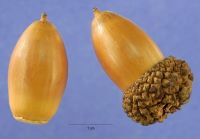 ); in transection with wing and from a folliclefollicle:
); in transection with wing and from a folliclefollicle:
a dry to (rarely) fleshy fruit derived from a single carpel that opens along a single longitudinal suture, derived from a single, superior, simple ovary; the seeds may be arillate or with a fleshy testa compressedcompressed:
compressedcompressed:
flattened; in grasses, used to denote compression (not necessarily flattened) either laterally or dorsiventrally
, or tereteterete:
approximately circular in cross section; width and thickness approximately equal
 (from a nutnut:
(from a nutnut:
a fairly large, indehiscent, dry fruit with a thick and bony wall surrounding a single seed, derived from a single, simple or compound ovary ); not bowl shaped; not nutlike; without winglike beakbeak:
); not bowl shaped; not nutlike; without winglike beakbeak:
a usually firm, terminal appendage, sometimes tapered ; without caudatecaudate:
; without caudatecaudate:
tapering to a long, tail-like appendage appendage(s); at maturity without food reserves, or with food reserves (Ballendena, Personnia), or without apparent food reserves; with endosperm (Ballendena, Personnia); without canavanine. Sarcotestasarcotesta:
appendage(s); at maturity without food reserves, or with food reserves (Ballendena, Personnia), or without apparent food reserves; with endosperm (Ballendena, Personnia); without canavanine. Sarcotestasarcotesta:
pulpy or fleshy outer layer of the seed coat, simulates aril absent. Testatesta:
absent. Testatesta:
seed coat
 present; without markedly different marginalmarginal:
present; without markedly different marginalmarginal:
at, on, or close to the margin or border
tissue; without fleshy or leatheryleathery:
texture—moderately thick, tough, and very pliable
layer over hard layer; tight; surface unsmooth; surface with merged raised features; surface wrinkledwrinkled:
surface relief—shallow, irregular folds and furrows covering the surface; appearing overall though crumpled and then spread out ; without crease or line separating cotyledons from hypocotyl-radicle; without notch along margin where cotyledons from hypocotyl-radicle tip approach each other; without glands; without bristles; glabrousglabrous:
; without crease or line separating cotyledons from hypocotyl-radicle; without notch along margin where cotyledons from hypocotyl-radicle tip approach each other; without glands; without bristles; glabrousglabrous:
without hairs
; with wing(s), or without wings; 1-winged; with wing at one end; without collar; without operculumoperculum:
a dehiscent cap (or lid) of a seed or fruit that opens during germination or dehiscence ; colored; monochrome; thin, or membranousmembranous:
; colored; monochrome; thin, or membranousmembranous:
texture—extremely thin, pliable, and fairly tough
, or woodywoody:
texture—consisting mainly of indurate lignified tissues, characteristic of or resembling wood
and thick (Macadamia); not becoming mucilaginousmucilaginous:
resembling mucilage; moist and sticky
when wetted; surrounding food reserve. Hilumhilum:
on seeds, the scar indicating where the funiculus was attached; on grass caryopses, the scar visible on the outer fruit surface revealing where the seed is attached on the inner fruit wall surface; or in Asteraceae cypselae, the scar visible on the outer fruit wall revealing where the fruit was attached to the receptacle larger than punctatepunctate:
larger than punctatepunctate:
surface relief—dotted with pits or with translucent, sunken glands or with colored dots, similar to pitted ; basalbasal:
; basalbasal:
at or pertaining to the point of attachment; (of embryo) embryo occupies one end of the seed
, or marginalmarginal:
at, on, or close to the margin or border
. Endosperm development nuclear; scant (Ballendena, Persoonia); without starch; with oils (Persoonia). Embryo differentiated from food reserve; well developed; 1 per seed; completely filling testatesta:
seed coat
 (no food reserve); 1 times the length of food reserve; at one end of seed not extending into a depression or cup; foliatefoliate:
(no food reserve); 1 times the length of food reserve; at one end of seed not extending into a depression or cup; foliatefoliate:
appearing leaf-like
; with spatulatespatulate:
2D shape—like a spatula; rounded at the apex, with base long and tapered; (of embryo) embryo is straight and axile and centric with the cotyledons expanded to form the shape of a spatula or spoon; (of cotyledons) cotyledons expanded and wider than the stalk but not invested into the stalk cotyledons, or investinginvesting:
cotyledons, or investinginvesting:
(of embryo) embryo is nearly or completely filling seed coat, straight, and axile and centric with spatulate cotyledons and covering the stalk for at least half its length; (of cotyledons) cotyledons spatulate and covering the stalk for at least half its length
cotyledons; straight; parallel to seed length; with cotyledons abruptly connected to hypocotyl-radicle, or gradually connected to hypocotyl-radicle; without coleorhiza; without simmondsin; without stomata; not green; with 2 or more cotyledons. Cotyledons 2 (3–8 Persoonia); well developed; 0.7–0.9 times length of embryo; somewhat to significantly wider than hypocotyl-radicle; 3–5.8 times wider than hypocotyl-radicle; not concealing hypocotyl-radicle; foliaceous; thin, or thick; flat; smooth; with apicesapex:
the point farthest from the point of attachment, or the "tip" of an organ entire; with margins separate; basally entire; unequal in size, or equal in size; not punctatepunctate:
entire; with margins separate; basally entire; unequal in size, or equal in size; not punctatepunctate:
surface relief—dotted with pits or with translucent, sunken glands or with colored dots, similar to pitted dotted. Hypocotyl-radicle small; not thickened.
dotted. Hypocotyl-radicle small; not thickened.
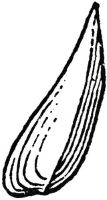 , smooth or rugoserugose:
, smooth or rugoserugose: or verrucoseverrucose:
or verrucoseverrucose: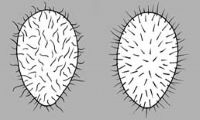 with points, occ. indehiscentindehiscent:
with points, occ. indehiscentindehiscent: , 1-celled, 1–2-seeded, anut, smara, or drupedrupe:
, 1-celled, 1–2-seeded, anut, smara, or drupedrupe: , occassionally capsulecapsule:
, occassionally capsulecapsule: , ollicel, 1–2-valved, 1–2-many-seeded, 1-celled or 2-celled by false septumseptum:
, ollicel, 1–2-valved, 1–2-many-seeded, 1-celled or 2-celled by false septumseptum: formed by membranes detached from testatesta:
formed by membranes detached from testatesta: of contiguous seeds, and separable into 2 plates. Airy Shaw: Ovary occ. borne on gynophoregynophore:
of contiguous seeds, and separable into 2 plates. Airy Shaw: Ovary occ. borne on gynophoregynophore: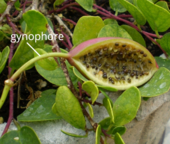 and at its base are commonly nectarial outgrowths.
and at its base are commonly nectarial outgrowths.Literature specific to this family: Johnson, L.A.S. & B.G. Briggs. 1975. On the Proteaceae - the evolution and classification of a southern family. Bot. J. Linn. Soc. 8:83–182.
General references: Airy Shaw, H.K. 1973. A dictionary of the flowering plants and ferns, 1,131 pp. University Press, Cambridge, Corner, E.J.H. 1976. The seeds of Dicots, esp. vol. 2. Cambridge University Press, New York, Cronquist, A. 1981. An integrated system of classification of flowering plants, 1,262 p. Columbia University Press, New York, Engler, A. & K. Prantl. 1924 and onward. Die Natürlichen Pflanzenfamilimien. W. Engelman, Leipzig, Gaertner, J. 1788–1805. De fructibus et seminibus plantarum. The Author, Stuttgart, Goldberg, A. 1986 (dicots) & 1989 (monocots). Classification, evolution, and phylogeny of the familes of Dicotyledons. Smithsonian Contr. Bot. 58 for dicots (314 pp.) & 71 for monocots (74 pp.). [Goldberg's illustrations are reproduced from older publications and these should be consulted], Gunn, C.R., J.H. Wiersema, C.A. Ritchie, & J.H. Kirkbride, Jr. 1992 & amendments. Families and genera of Spermatophytes recognized by the Agricultural Research Service. Techn. Bull. U.S.D.A. 1796:1–500, LeMaout, E. & J. Decaisne. 1876. A general system of botany, 1,065 p. Longmans, Green, & Co., London, Mabberley, D.J. 1987. The plant-book, 706 p. Cambridge University Press, Cambridge, Schopmeyer, C.S. 1974. Seeds of Woodywoody:
texture—consisting mainly of indurate lignified tissues, characteristic of or resembling wood
plants in the United States. Agric. Handb. 450:1–883, and Spjut, R.W. 1994. A systematic treatment of fruit types. Mem. New York Bot. Gard. 70:1–182.